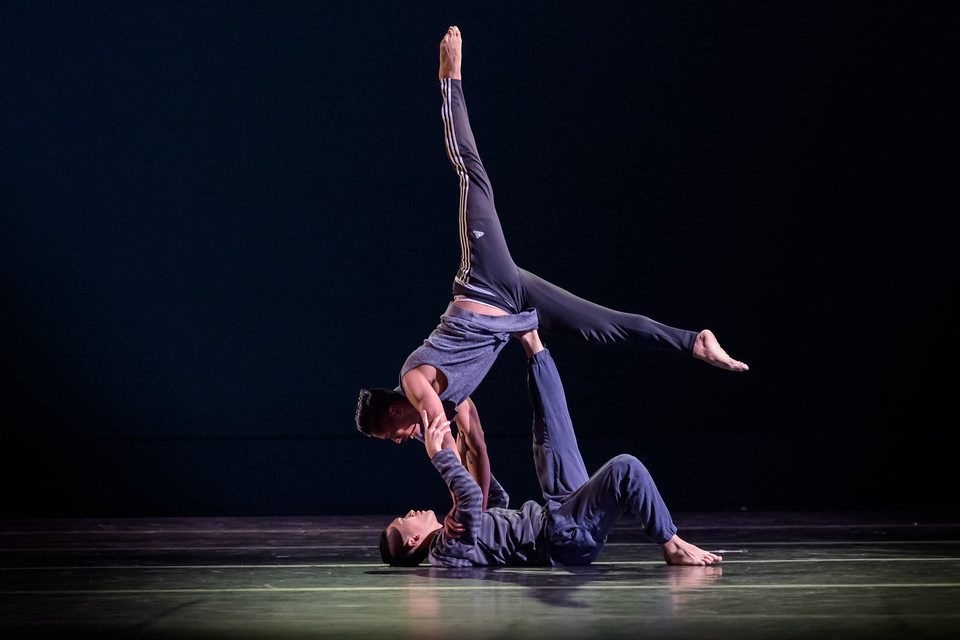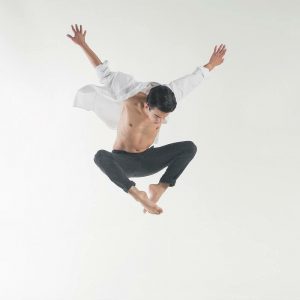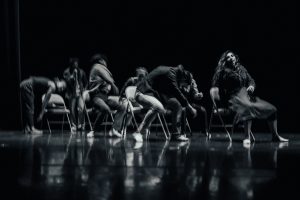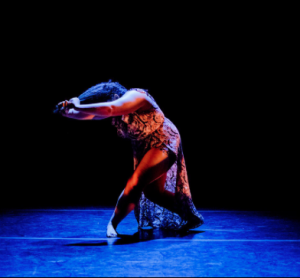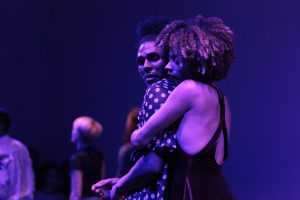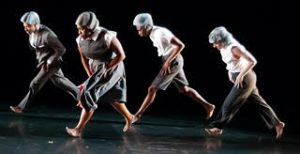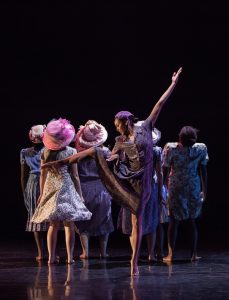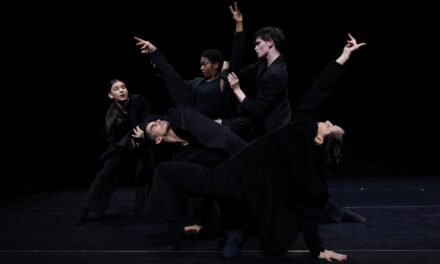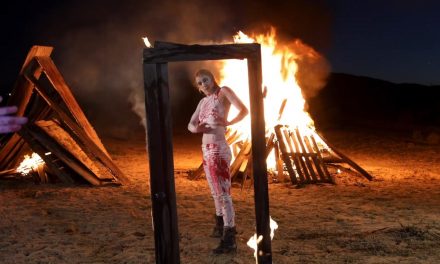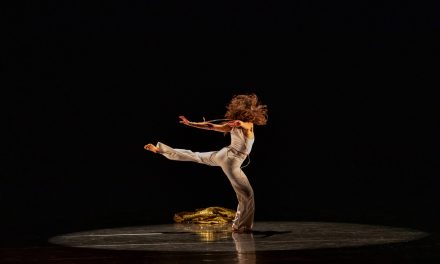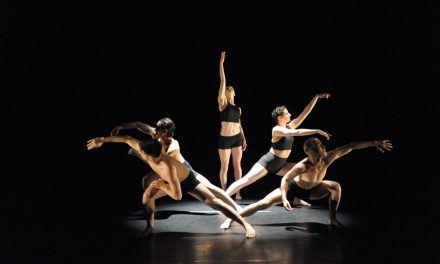The BlakTina Festival presented its fifth season at the BootLeg Theater in Los Angeles, featuring nine works by a diverse group of choreographers from the LA area and beyond. For this program, it was primarily the duets that held my attention. They were exciting, distinctive and beautifully made. The group works did not hold up as well, although two did present powerful imagery and social commentary and one was pure entertainment. The Artistic Directors of the BlakTina Festival, Licia Perea and Alicia Adams, have put a great deal of work and energy into finding talent for and promoting the festival. Their efforts have resulted in building a loyal audience and the Friday night performance was sold out.
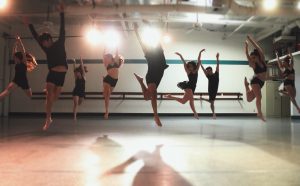 Anthony Aceves is a co-founder and artistic director of Akomi Dance. His A Piece of Love (for Johnny & Eva) began nicely, but it soon dissolved into an academic level composition piece saturated with unison phrases. The movement was vapid and pretty with very pregnant pauses between sections; leaving the dancers standing awkwardly while waiting for the music to begin. Aceves made brief attempts at breaking up the unison but he failed to trust those instincts by retreating into more comfortable territory. The talented cast included Scott Alexander, Daniel Diaz, Dani Furniss, Damian Kelly, Jessie Mays, Amy Walper and Matthew Wiley, dancing to Stand By Me and At Last by Bootstraps.
Anthony Aceves is a co-founder and artistic director of Akomi Dance. His A Piece of Love (for Johnny & Eva) began nicely, but it soon dissolved into an academic level composition piece saturated with unison phrases. The movement was vapid and pretty with very pregnant pauses between sections; leaving the dancers standing awkwardly while waiting for the music to begin. Aceves made brief attempts at breaking up the unison but he failed to trust those instincts by retreating into more comfortable territory. The talented cast included Scott Alexander, Daniel Diaz, Dani Furniss, Damian Kelly, Jessie Mays, Amy Walper and Matthew Wiley, dancing to Stand By Me and At Last by Bootstraps.
The definition of the word prototype is “a first, typical or preliminary model of something, especially a machine, from which other forms are developed or copied”. Regina Fergerson and Luis Vazquez have created a beautiful and quiet work titled Prototype that quickly captures and retains one’s attention. The work borders on being meditative in its relationship to the music of Philip Glass and Bruce Levingston, but looking deeper into the work, one sees a relationship that is both reliant on but independent of these two characters. Fergerson and Vazquez perform echoing gestures, that hint at being robotic, with care and precision, but they never become mechanical or inhuman. In fact, as the dance progresses, they become more intimate and caring of each other. This was a duet that I hope to see again.
madam fatale By Mallory Fabian had moments of clarity, but the piece did not actually come into focus until it was almost finished. The six women strutted, mugged and vamped around the stage occasionally performing confrontational movement phrases, but it was not until the final quartet that Fabian began to make an honest, uncluttered statement. The performers of the company fabe, were Darby Kelley, Kelsey Long, Mallory Fabian, Angelica Olivares, Patrice Roth and Sarah Polednak. The driving music was by Lynn Suemitsu.
Alvin Rangel has created an insightful and tender work titled Now. The music that Rangel chose is the once familiar Piano Concerto No. 21 in C by Mozart. This score was used throughout the 1967 movie Elvira Madigan, a tale of forbidden love. Rangel has taken a well-known subject and given it new life. In Now, two men wearing hoodies pace around the edges of sexual attraction without the dance ever becoming overtly sexual. We see and feel the magnetism, their hesitation and finally their acceptance. As in Elvira Madigan and Shakespeare’s Romeo and Juliet, the ending is tragic. It is Rangel’s choreography and the performances of Alexander Caballero and Chris Jensen that give a new insight into society’s mores regarding who can love whom.
Ashley Baker is a dancer and choreographer based in Phoenix, Arizona. Her solo, MULATO examines the struggles of a woman born to white and black parents. Baker is a good performer who depends heavily on the text of a spoken word piece by Vanessa Marco titled Off White. The conflict is a woman of mixed race moving between two very different cultures, society’s reaction to her appearance and the internal struggle this causes. MULATO is a very personal work but it is the words and intensity of Marco vocals that I will remember.
I admit that the meaning behind Sofia Carreras’ flor de mi alma (Flower of My Soul) escaped me. I did, however, enjoy watching the interaction of its characters. Carreras placed her cast in chairs that lined each side of the stage, giving a sense of travelers seated in a waiting area. These lonely souls interact, but they seldom commit emotionally. There is an outcast woman and an outsider looking in. A single white flower is passed from one person to another, along with a suitcase that never actually finds its true owner. The performers are strong and the work is thought provoking, but what is not clear is Carreras’ message. The members of Intersect Dance Theatre were Aisha Bardge, Morgan Davison, Betti Guerra, Olivia Hamilton, Jack Kim, Justin Morris, and Alicia Slaughter. The compelling score was by Alberto Iglesias.
The third duet, RISE AND SHINE, was choreographed and beautifully performed by Cuban born Joan Rodriquez and Taimy Miranda, who are co-artistic directors, choreographers and core performers of Stilo Dance Company. The two highly trained dancers moved as one throughout RISE AND SHINE. Their complex partnering and intricate lifts were flawlessly executed as the piece quietly shifted from a pure movement theme into a loving relationship. With each new section, pieces of clothing were cleverly discarded without interrupting the flow of movement. The constant intertwining of bodies bordered on becoming stale, but I never tired of watching these beautiful dancers move. The music was by Dutch composer Joep Beving, Molife, and Leon Noel.
The excerpt of Add Water & Stir by Brigette Dunn-Korpela presented on this program was powerful, compelling and it clearly sent a message to the world that we must not forget the mostly male black men who are being murdered in this country. The entire cast was “of color” except for a lone Caucasian woman (Kestral Leah) sitting at a table mindlessly making cake batter. She sat staring blankly into space, her hair appearing lacquered into place and wearing white heels and a clear plastic apron over a suburban house dress. While stories of young black men being murdered by police and white hate groups are being presented, she pretends not to notice or to be empathetic to their plight. One by one, the dancers relate the events that took the lives of Tamir Rice, Eric Garner, and Emmett Till. The very descriptive telling of Emmett Till’s young battered face while lying in an open casket is especially unsettling. The choreography is strong and the movement rigorous. The talented cast of the B. Dunn Movement company included Brance Souza, Whitney Jackson, Cynthia Anderson, Joan Holly Padeo, Dion Pratt, and Kestral Leah. Animation was by Nak Choi with set design by Shannon Knox. Costumes were designed by Hannah Athena Lawton.
The evening closed with the dancey crowd-pleasing Masimuke. Opening with a single back flip, the energy level never sagged. This entertaining work was choreographed by the very talented Irishia Hubbard, artistic director of The Hubbard Collective. The dynamic group included Edgar Aguirre, Eric Whitehurst, Kristy Dai, Sienna Serrano, Audrey Fernandez, Nickolas Sosa, Noelle White, Thomas Harlin, Jayar Rodriguez, and Irishia Hubbard.
The BlakTina Festival is an excellent venue for often unheeded African American and Latina/Latino dance artists. For more information about the festival, click here.

